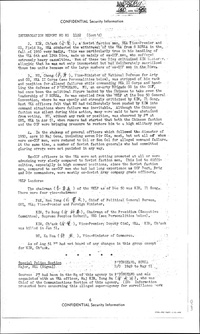특경부(特警部, Special Police Section)는 북한 정권 출범후 6.25 전쟁 기간에 북한에 존재했던 Cominform (Communist Information Bureau, or Information Bureau of the Communist and Workers’ Parties)[1][2]의 감시기관이다. 이러한 기구의 존재는 6.25 때 미군이 인민군 포로를 신문하여 얻은 정보 기록에 나온다. 1948년 9월 북한 정권 수립과 함께 소련군 철수 후 평양의 소련 대사관이 북한 정권을 감독하는 일을 맡으면서 감시기구로 설치한 것으로 보이나 자세한 사항은 알려져 있지 않다.
개요
- 평양 본부의 위치 : 39°02'14.0"N 125°45'34.0"E 구글지도
김일성 본인도 특경부의 감시로부터 자유롭지 않았다고 하므로 소련은 6.25 전쟁 시기에도 북한에서 감시기구를 운영하며 절대적인 영향력을 행사하고 있었던 것으로 보인다. 1951년 1월에 김일성이 한 연설이 문제가 되어 특경부의 지적을 받았다고 한다.
미군의 특경부 관련 포로 신문 기록
- PW : Prisoner of War
- Hq : Headquarters
- aprx : approximately
- CCF : Chinese Communist Forces (중공군)
INTERROGATION REPORT NO KG 1122 (Cont'd)
should be viewed with the utmost reserve, pending further confirmation.)
Identification:
The Spccial Police Section (特警部) was asserted to be the surveillance agency of the COMINFORM (Communist International Information Bureau, the successor to the Third Communist International) in N KOREA (sic).
Background: PW first heard that the Special Police Section (SPS) was in P'YONGYANG in 1949 (from Maj KIM) but it apparently did not become very active until the start of the Korean War. The SPS's earlier history is unknown.
P'YONGYANG Hq: SPS Hq in P'YONGYANG was housed, as of May 51, in aprx 15 underground tunnels dug into the foot of a hill located at aprx 39°02'14" - 125°45'34" (coordinate readings taken from JANIS 75, Plan 42). Entrances to tunnels faced E, toward the TAEDONG River, Tunnel entrances were 30 - 40 m apart and extended along the foot of the hill for aprx 450 m. Tunnels led horizontally straight into the hill, ranging in horizontal depth from 30 to 60 m, and were aprx 3 m high and 6 - 10 m wide, with concrete lined walls and ceilings and wooden floors, A passageway ran along one side of the entire length of the tunnel, the other side being partitioned by wooden planks into a row of offices, detention cells, interrogation booths, etc. Tunnels were equipped with electric lights, telephones, power-driven air circulators and emergency generators.
Organization and Personnel:
According to Maj KIM, there were about 80 men in the P'YONGYANG Hq. KIM also talked as if the SPS had branch offices in all parts of N KOREA but all knew nothing specific about such offices. SPS agents in P'YONGYANG were of various nationalities - - SOVIET, Korean, Hungarian, Czech, Chinese and possibly others. Soviet personnel seemed to be directing most of the agency's activities, while the field agents were mainly Koreans. There was no particular uniform for SPS agents, who wore whatever civilian clothing or NKA, or other uniforms were necessary for their purposes. Maj KIM said that agents normally carried concealed weapons.
PW did not know whether the SPS had any connection with such Soviet agencies as the MGB, MVD or the Soviet Army's Main Administration of Counter-Intelligence. PW had never heard of these agencies nor had he seen any men at the SPS who wore the black uniform of the MGB or the green-trimmed hats and epaulets of the MVD.
However, PW's statement that the SPS was the surveillance arm of the COMINFORM was borne out, in his opinion, by statements to this effect by Maj KIM and a number of NKA officers who knew about the agency and the numerous nationalities represented among SPS men.
Authority and Operations: The SPS was concerned with political surveillance of any and all persons in N KOREA. It watched for any signs of political deviation and for failure to carry out assigned tasks. In actual practice, it concentrated on higher-ranking civil and military officials. Minor cases were turned over to the NKA or NKG civil authorities.
According to Maj KIM, it could, in theory at least, arrest and execute any person without trial or explanation. PW had not heard of any cases in which persons were actually executed by the SPS. Whether it had any jurisdiction over CCF men was unknown. PW had never heard of any high-ranking CCF men being arrested by the SPS.

